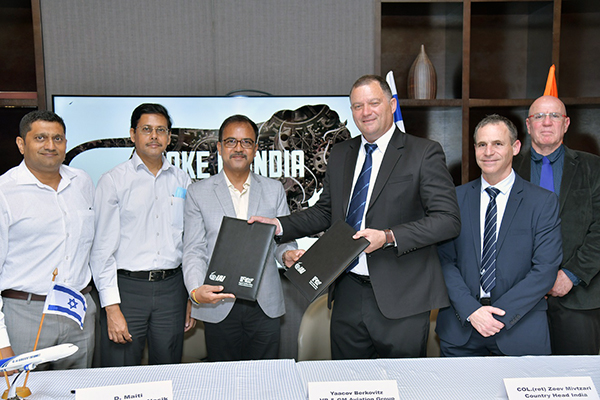

Hindustan Aeronautics (HAL) announced, on 6 April, the signing of a memorandum of understanding (MoU) with Israel Aerospace Industries (IAI) to convert civil passenger aircraft to “multi mission tanker transport” (MMTT) aircraft in India.
For the past decade-and-a-half, the Indian Air Force (IAF) has been trying to buy six MMTT aircraft to supplement its eight obsolescent Russian Illyushin-78 refuellers. So dire is the IAF’s shortfall of refuellers that, to fly in its new Rafale fighters from France, it had to ask Paris for Airbus refullers to top up the Rafales’ fuel tanks over the Mediterranean Sea.
In two abortive procurement attempts in the past 15 years, the IAF has floated tenders to Ilyushin and Airbus. If a tender is floated afresh, there will be a third vendor in the fray – The Boeing Company, which has developed the KC-46 Pegasus tanker aircraft for the US Air Force.
The reason for the IAF’s withdrawal of both tenders was a conflict between “procurement cost” and “life cycle cost”. Russia’s IL-78 tanker is cheaper; but the Spanish Airbus 330-200 tanker worked out cheaper in terms of life cycle costs – considering not just the acquisition cost, but also the cost of operation, maintenance and spares over a 30-year service life.
With leasing of defence equipment now permitted under the Defence Acquisition Procedure of 2020, the IAF could also lease, rather than buy refuellers.
The last option now available – converting civil airliners to refuelling tankers – mirrors the IAF’s “Phalcon model” – in which it approaches Israel to convert a Russian IL-76 into a Phalcon radar-fitted AWACS.
Tankers are valuable force multipliers for air forces such as India’s, which operate fighters for long-distance missions. Mid-air refuelling almost doubles the operating range of fighters. Refuelling them mid-mission saves a trip back to base, and a landing and take-off.
Under the new MoU, “HAL will convert pre-owned civil passenger aircraft into air refuelling aircraft with cargo and transport capabilities. The move, will provide India’s defence ecosystem with new capabilities and cost effective solutions in the market,” said the IAF.
“The MoU will facilitate HAL and IAI’s decades’ long expertise in developing, manufacturing and producing leading defence platforms. The scope of the MoU also covers ‘passenger to freighter aircraft’ conversion, along with MMTT conversions.
“We are glad to join hands with our long-standing partner, IAI, in this venture of MMTT conversion business which is one of the strategic diversification avenues identified by HAL,” said HAL chief, R Madhavan.
IAI has experience in modified aircraft for the IAF. In the early 2000s, IAI fitted the Phalcon radar into three IAF IL-76 aircraft, converting them into Airborne Warning and Control Systems (AWACS).
Boaz Levy, president and CEO of IAI, said: “We are proud to come together with our counterparts to bring our best value MMTT solution in India, while utilising local resources to manufacture and market the platform. By collaborating with HAL and bringing conversion directly to India, we are supporting the ‘Make in India’ campaign”.
With the Russian options considered outdated, the IAF will probably have to choose between the Airbus and Boeing options. The Airbus 330 MRTT carries more fuel than the KC-46A Pegasus – 111 tonnes, as against 96 tonnes – but which remains in many respects a civilian airliner that retains commercial airline-style seating inside for 291 passengers.
Boeing marketing executives argue: “The KC-46A is not just a civil airliner that can carry extra fuel. It has been developed as a military aircraft, to the demanding specifications of the USAF.”
The KC-46A Pegasus has modular, military style, palletised seating that can be quickly bolted on for up to 160 passengers. Alternatively, it can carry 54 stretchers with patients.
The KC-46A’s tanker-specific avionics include state-of-the-art displays developed for the 787 Dreamliner. The USAF has insisted on the “boom operator” – who operates the boom that pumps fuel at 1,200 gallons per minute into the aircraft being refuelled – having a three-dimensional view from seven cameras that look to the rear. The pilots too can view the entire operation, which allows them to position their tanker aircraft suitably.
Airbus, however, points out that its A330-200 has won practically every MRTT contest in the world. It has logged orders from the air forces of Australia, the UK, France, Saudi Arabia, The Netherlands, Singapore, South Korea, and the UAE.
However, a senior Boeing executive points out: “Those orders were placed when the KC-46A hadn’t entered service. Now, it provides India an additional option — one that consumes 30 per cent less fuel, is 20 per cent cheaper to operate, and that is derived from an aircraft with a despatch reliability rate of 99.7 per cent.”
















